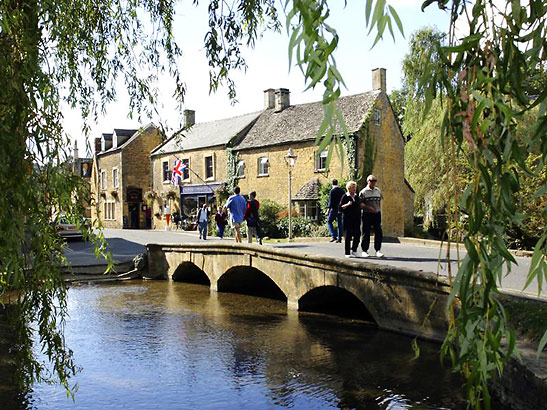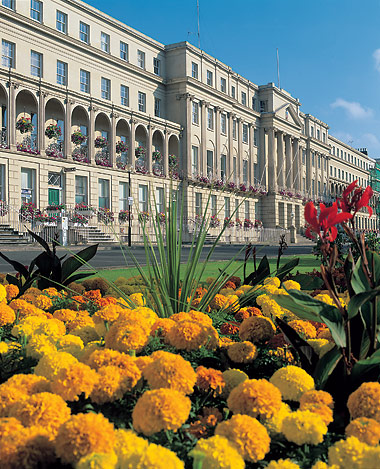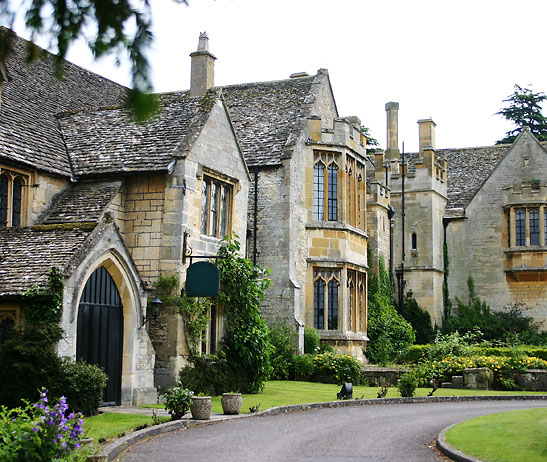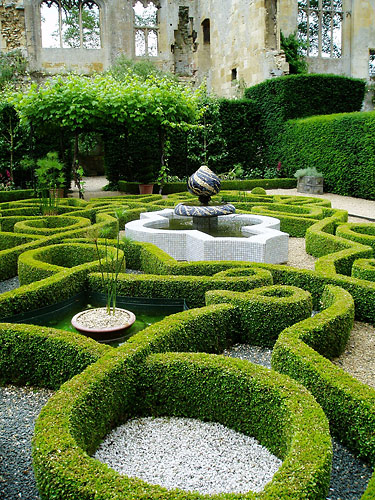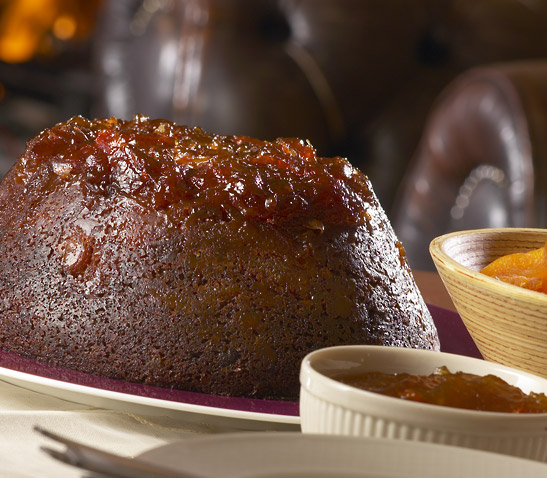 |
 |
|
 |

|
Cotswolds - Bourton-on-the-Water
The village also has an assortment of antique shops, tea rooms, small inns, private cottages hidden behind a profusion of colorful blooms, and a rather large population of Golden Retrievers. When I ask a gentlemen walking the fifth Golden I’ve seen in an hour about their numbers, he smiles and answers, “Yes, quite. Around here, they’re called Cotswold dogs.” I would call them lucky dogs – to have such a glorious region as home. Located about two hours west of London, the Cotswolds, a hilly area of Outstanding Natural Beauty, is famous for “chocolate box” villages with fairy tale names – in addition to Bourton-on-the-Water, there’s Chipping Campden, Stow on the Wold, Moreton in Marsh, Upper and Lower Slaughter, Shipston-on-Stour and Wotton-under-Edge. So perfect are the villages one wonders if they aren’t backdrops for Thomas Kinkaide paintings, rather than the dwelling places of real live people. People do live here – many wealthy Londoners in search of a second home and a slew of celebrities, including Kate Moss, Kate Winslet, Stella McCartney, Hugh Grant and royals, from Zara Phillips to Prince Charles, whose estate High Grove is the most famous of the Cotswold residences, as well as regular folks who were lucky enough to have bought their cottages before area real estate went through the proverbial thatched roof.
A good base for touring the Cotswolds is the spa town of Cheltenham, often called the best preserved Regency town in England. Stroll the tree-lined Promenade, as visitors have done for nearly 300 years, taking in Neptune’s Fountain, modeled after Rome’s Trevi Fountain, the Imperial Gardens and the Montpelier area, where a row of caryatids, sculpted female figures, serves as architectural support for the buildings, most of them now housing boutiques, tea rooms and cafes, which spill out onto flower-bedecked terraces. If you do stay in Cheltenham Spa, you will do no better than the Ellenborough Park Hotel, adjacent to the town’s race course, famed for its steeplechase races (the newlyweds William and Katherine are said to be particular fans of the track.) Once the country estate of Lord Ellenborough, Governor-General of India during Queen Victoria’s reign, it is everything besotted Americans such as me look for in a grand English manor. I had my morning coffee in the Great Hall, my evening cocktail in the Minstrels’ Gallery overlooking the Great Hall, and retired each evening to a four-poster bed in a room with a view of the expansive gardens. I didn’t, however, have the room where, with the aid of binoculars, you can see the race course’s finish line while sitting in the bath tub, or the room with a secret staircase allowing guests to have nocturnal visitors without fear of embarrassment.
From Ellenborough Park it’s an easy drive to such quintessential Cotswold villages as Chipping Campden and Broadway, but on the way save time for a stop at Sudeley Castle, which can date its history back 1,000 years when King Ethelred the Unready gave the property to his daughter Goda on the occasion of her marriage. The current castle is most famous as the home of Henry VIII’s final wife Catherine Parr, and in 2012 will celebrate the 500th anniversary of her birth with a year-long schedule of events. The castle gardens are spectacular, particularly the secluded Knot Garden, which incorporates a design from a dress pattern worn by Elizabeth I in a portrait that hangs in the castle.
Another garden you won’t want to miss is the Painswick Rococo Garden, a restoration of an 18th century pleasure garden. Flamboyant and flashy, as the trend of the times warranted, the gardens feature a miniature Doric temple, Gothic alcove, water features, and a maze. While most people think the best time to visit an English garden is in the spring or summer, a good time to visit the Painswick Garden is late February and early March when a carpet of snowdrops spreads across the woodland floor. Chipping Campden, a settlement since the 7th century, has a High Street that has been described by historian G. M. Trevelyan as “the most beautiful village street now left on the island.” While you may be tempted to stick to the High Street, with its impressive medieval Market Hall and array of one-of-a-kind shops, do detour to the lovely St. James Parish Church to wander through the graveyard with its moss-covered headstones. Broadway is often referred to as the show place of the Cotswolds, and in this region of picturesque villages, that is quite a tribute. It basically consists of one main street (formerly a coach road between London and Worcester) skirting a village green with rows of honey-colored limestone buildings on either side. One of these buildings, the Lygon Arms Hotel, has welcomed guests for centuries, including the two rivals in the English Civil War, King Charles I and Oliver Cromwell, although presumably not at the same time. In the 19th century, the village became a gathering place for writers (J. M. Barrie and Henry James), musicians (Edward Elgar) and artists (John Singer Sargent and Frank Millet), and in the early 20th century, it was a center for the Arts and Crafts movement, with William Morris a frequent visitor and furniture maker Gordon Russell opening a shop, which is now a museum. A great way to see Broadway is to take a walking tour with local artist Jeremy Houghton, who has been named one of the official artists for the 2012 Summer Olympics in London. In his tweed jacket and Wellies, Houghton proved the perfect guide to all the spots frequented by the “Broadway Colony.”
All Hail the Great British Pudding “Now, everyone remember to bang your spoons as each pudding is introduced, because as you know, puddings have feelings too!” So spoke the Pudding Master as he prepared to announce the Parade of Puddings at the weekly Friday night meeting of the Pudding Club in the village of Mickleton. As each pudding was paraded with great ceremony into the room – beginning with the Treacle Sponge, followed by the Jam Roly Poly, Spotted Dick, Lord Randall’s Pudding, Apple Crumble and Summer Pudding and concluding with the Squidgy Chocolate and Nut Pudding - a thunderous cacophony of spoon-banging ensued. Founded here at the Three Ways House Hotel in 1985 to prevent the demise of the Great British Pudding, the Club has no dues, no members (everyone’s welcome) and no hard and fast rules other than you must finish one pudding before starting on another. Over the 26 years of its existence, the Pudding Club has served some 100,000 pudding lovers – not just in Mickleton, but at special events in London, Dublin, New York and Tokyo. The evening offers pomp and circumstance mixed with frivolity and comfort in the knowledge that the British Pudding indeed appears safe from the challenge of frozen cheesecake and tasteless gateaux. If you do want to attend, book ahead as the weekly meetings are wildly popular, but if you do get in, you’ll probably decide that this is the best club you’ve never been a member of. Related Articles: |

FEEDBACK FOR PATTI I enjoy your newsletters -and particularly Patti Nickell's article
about the 'Pudding Club' in the Cotswold's. An old friend of mine is taking
a holiday there this year and plans to try their Jam Roly Poly and Spotted Dick
- amongst many!
FEEDBACK FOR JULIO The way I read this article, you stayed at the "Breeze
and Waves". Do you have any pictures of the cottages, and would you recommend
to some first time visitors to Caramoan? Hi Richard, Breeze and Waves was still under construction when I stayed
there in Feb. 2010. It should be finished by now. You
can see pictures of the resort on this page. We got to stay in one of the
small cottages in the picture. I'll recommend it to budget travelers but you
might want to look at other options. We chose it because of its location right
by the beach. You can try other resorts in the Caramoan town proper (you have
to get a ride to get to the beach and the jump-off point to go island-hopping
but it's a relatively short distance). There are also two higher end resorts
located on a cove and very near the islands: Gota Village Resort (unfortunately
there is something wrong with their website right now) and its twin resort Hunongan
Cove. Caramoan is a relatively new tourism development so resorts are just now
being built. I should add that it might be good to go to Caramoan (and almost anywhere in the Philippines) during the dry season from December to May. June to November are the typhoon months and sometimes typhoons will still come during early December. Julio * * * * * Hi, I'm planning to go to Caramoan this coming May. Would you
know the number of Breeze and Waves Cottages? Thanks! Hi Ann, Breeze and Waves' phone number is 0908-2911072. Look for Freddie. Hope you have a grand time at Caramoan! Julio
FEEDBACK FOR WENDY For Nature's Playground: The South Island of New Zealand Hi Wendy, In winter, Heritage Heights Apts. now offers free shuttle service to and from Queenstown 24/7 to guests without cars. We own a 7-passenger 4-wd Toyota Highlander used specifically to taxi guests up and down the hill during winter months. We also run advance purchase winter promotions which include a 4-wd rental. If any of your readers head over this direction, I will enjoy extending Heritage Heights hospitality!! Cheers --- Ailey, Owner, Queenstown, NZ * * * * * New Zealand text and pix top drawer! Almost as good as making the trip. ( but one still wants to. . . ) Full of useful detail. Only trouble with the website: It's tough figuring out which feedback goes with which article, and the more there are, the tougher it gets! --- Ken W., Camarillo CA Thanks Ken..."álmost" is right, you really have to experience the South Island firsthand. Granted this piece is long, but still all I can think about is how much I left out! I agree abut the relevancy factor re the feedback--it can be confusing...sometimes I have a "Wait a minute...what?" moment myself. Thanks for writing, Wendy * * * * * Okay Wendy, from now on whenever you book your travel, please reserve space for me. I will carry your luggage, bring you cold drinks, massage your shoulders, and change the film in your camera (oops, I guess you don't have to do that anymore). Wonderful ideas and recommendations. Can you get to New Zealand from Boston in less than a week? --- Carl A., South Easton, MA Ha ha ha Carl, you're quite the comedian! But you'd be surprised how short that flight feels. I suspect Qantas isn't the only airline who's figured out that 3 movies, 2 full meals, lots of snacks and a complimentary travel pack (eye mask, warm socks and neck pillow) equals a quiet, well-behaved cabin. It really isn't bad. Just fly direct--pick the shortest flight w/ no lengthy layovers and you'll be fine. Re: signing on as my Super Sherpa...why not? I think you know I seldom travel in anything less than Party mode. There's just that pesky background check... Thanks for writing, Wendy For Excellence Riviera Cancun: Wendy, I truly enjoyed your info especially since we leave in a week to celebrate my 50th Birthday. Was it necessary to make reservations at the restaurants? Was there a dress code for the restaurants? What would you recommend not missing while there? Was the spa experience worth it? Did you travel away from the resort while there? Thanks, --- Kim P. Fuquay, Varina, NC Hi Kim. Sorry for the delay in responding...you had heavy competition with the holidays. Reservations at Excellence restaurants are not necessary and you will not find a wait. The dress code is basically no bathing suits and flip-flops...with a decided a mix of atmospheres. Mostly the open-air beachside spots are super casual, the rest slightly more formal. Truly, as long as you are clothed, I don't think you'd be turned away anywhere, though most people seemed to enjoy dressing up at night...I suspect more for their own pleasure than any sense of decorum. The spa experience was worth it, though my favorite part wasn't the actual massage. The precursor was a 45 min. or so rotation from sauna to a series of (kind of wild) water jets which was very different and very cool, not just for women. In its' entirety, and with the serenity of the beach/champagne/strawberries, it was memorable. We did not travel away from the hotel this trip, but the hotel is very helpful in arranging day excursions to fit your desires and you do not have to book these until you arrive. Have a great time! --- Wendy
FEEDBACK FOR NINO I enjoyed Nino's contribution, since we all read about the frightening
terrorist attack. Having travelled somewhat through India years ago, I am continually
impressed with this country and the gentle spiritual aspects of this nation.
Some day I look forward to going back. Nino has encouraged me. Thank you!
FEEDBACK FOR RUSH & CHUCK Dear Mr.s/counselors Brown and Koro, Thank you for a very informed and succinct article on motorcycle accidents and the law. It inspired me to think about getting a motorcycle, but not have an accident. But, if I do I am now well informed with the basics of what to do providing I do not perish in the accident. Any tips about that too? --- Unnamed
Dear Rush and Chuck, I wish I had read your article before our camping trip the Friday prior to President's Day. My wife and I were in a car accident on our way to a camp ground. We were "rear-ended" and the impact caused our car to crash into the car in front of us. The contents of the truck that we were riding scattered onto several lanes. It's a miracle our two dogs decided to stay inside the car. My wife and I were shaken up badly but despite the mess, I was still able to walk out of the car. I got the license plate of the driver in front of me but, to my surprise, after reviewing the little damage on his car, he then sped off. I didn't know you could do that! The driver who hit me from behind gave me his information and then he too left the scene without saying good 'bye. When the police arrived all I had to go by was the little information I had jotted down which I hope was truthful. What if it was bogus? What if I had written the plate number incorrectly? How would that affect my insurance? What if we were unconscious, who would have written down all that information? I do have one suggestion if you are injured in an accident. The police asked if my wife wanted an ambulance to bring her to the hospital but we declined the offer. I remembered when I rode an ambulance years ago that it was not a comfortable ride. I was strapped to the stretcher and there were all sorts of medical equipment dangling noisily above me. As long as you are able, it is a more relaxful ride inside a car. Besides, isn't there a fee for ambulance service? --- Dave S. of Pasadena, CA
|
This site is designed and maintained by WYNK Marketing. Send all technical issues to: support@wynkmarketing.com

|











